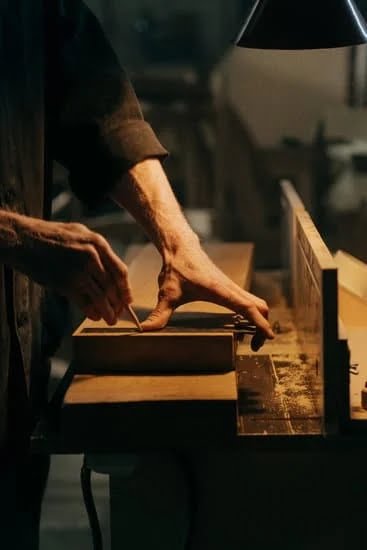Can you glue a toe strip on woodwork to enhance its durability and aesthetic appeal? Adding a toe strip, also known as a shoe moulding or base trim, not only provides a finishing touch to woodwork but also serves practical purposes. These strips protect the bottom of cabinets, furniture, or baseboards from damage caused by foot traffic, vacuum cleaners, or mops. They also help hide imperfections and gaps along the floor.
When gluing a toe strip on woodwork, you will need specific materials such as adhesive glue, sandpaper, and clamps to ensure a secure attachment. Safety precautions are essential when working with glue and wood – proper ventilation and protective gear must be used to avoid any accidents. Preparation of the woodwork surface is key to achieving a successful bond between the toe strip and the base material.
Following detailed instructions on how to properly glue a toe strip onto your woodwork is crucial for a seamless finish. Clamping the toe strip in place and allowing it to dry thoroughly are necessary steps in the process.
Once dried, sanding and applying finishes will give your glued toe strip an impeccable look. By understanding how to maintain this attachment properly and avoiding common mistakes during the gluing process, you can enjoy the benefits of a durable and attractive toe strip on your woodwork for years to come.
Materials Needed
When it comes to gluing a toe strip on woodwork, having the right materials is essential for a successful and durable finish. Here is a list of materials needed for this project:
1. Toe Strip: The main component of this project, the toe strip should be cut to the appropriate length and width to fit the woodwork properly.
2. Wood Glue: Choose a high-quality wood glue that is suitable for bonding wood surfaces together.
3. Clamps: Clamps are necessary to hold the toe strip in place while the glue sets and dries. Make sure you have enough clamps to secure the entire length of the toe strip.
4. Sandpaper: Sandpaper will be needed to smooth out any rough edges or uneven surfaces before applying the glue.
5. Paintbrush or Roller: A paintbrush or roller can be used to apply an even coat of glue onto the wood surface and toe strip.
6. Protective Gear: Safety goggles and gloves are important to protect your eyes and skin from any potential splashes or spills during the gluing process.
Gathering all these materials before starting your project will ensure that you have everything you need for a successful outcome. Now that you have your materials ready, it’s time to move on to preparing the woodwork surface for gluing the toe strip securely in place.
Safety Precautions
When working with glue and wood, it is essential to prioritize safety to prevent any accidents or injuries. Here are some important safety tips to keep in mind before you start gluing a toe strip on woodwork:
- Make sure to wear appropriate protective gear such as gloves and safety goggles to protect your hands and eyes from the adhesive and any flying particles.
- Work in a well-ventilated area to avoid inhaling fumes from the glue, which can be harmful to your respiratory system.
- Avoid direct skin contact with the adhesive and clean up any spills immediately to prevent skin irritation or allergic reactions.
- Keep sharp tools out of reach when not in use to prevent accidental cuts or injuries while handling the woodwork.
By following these safety precautions, you can ensure a safe and successful project when gluing a toe strip on woodwork. Remember that taking the time to prepare properly and work safely will lead to a satisfying outcome without any unnecessary risks.
- Always read and follow the instructions provided by the manufacturer for both the glue and any other products you are using during the process.
- If using power tools for preparation or finishing touches, make sure they are in proper working condition with safety guards in place.
- In case of accidental contact with glue or sharp objects resulting in injury, seek immediate medical attention to prevent further complications.
Taking these safety measures seriously can ensure that your DIY project of gluing a toe strip on woodwork is not only successful but also injury-free. It’s always better to be safe than sorry when working with potentially hazardous materials like glue and woodworking tools.
Preparation
After cleaning the surface, you may also need to sand it lightly to create a better bonding surface for the glue. Sanding helps roughen up the wood slightly, allowing the adhesive to grip onto it more effectively. Make sure to clean off any sanding residue before proceeding with gluing.
Additionally, if there are any existing finishes or coatings on the woodwork surface, consider removing them in the area where you plan to attach the toe strip. This will ensure that the glue can penetrate and bond directly with the wood fibers.
Once the surface is clean and prepped, carefully measure and mark where you want to place the toe strip on your woodwork. Precision in this step is essential as it will determine how accurately and securely your toe strip attaches. Double-check your measurements before moving on to applying adhesive as any mistakes at this stage can affect the final result of your project.
| Preparation Steps | Benefits |
|---|---|
| Clean and dry the surface | Ensures strong bond between toe strip and woodwork |
| Lightly sand the surface | Improves adhesion of glue by roughening up wood |
| Measure and mark placement of toe strip | Precision ensures accurate attachment of toe strip |
Gluing Process
Gluing a toe strip on woodwork is a relatively simple process that can enhance both the aesthetics and durability of the furniture piece. A toe strip, also known as a kick strip, is typically used at the base of cabinets or other woodwork to protect against kicks and scuffs. It serves both functional and decorative purposes, adding a finishing touch to the piece. Gluing it in place ensures a secure attachment that will withstand everyday use.
To successfully glue a toe strip on woodwork, you will need a few essential materials:
- Toe strip
- Wood glue
- Clamps
- Sandpaper
- Damp cloth
Before proceeding with the gluing process, it is important to take some safety precautions. Always work in a well-ventilated area to avoid inhaling any fumes from the glue. Additionally, wear protective gear such as gloves and safety goggles to prevent any accidents while handling tools and materials.
Now, let’s walk through the detailed instructions on how to properly glue a toe strip on woodwork:
- Measure and cut the toe strip to the required length.
- Apply a generous amount of wood glue along the back of the toe strip.
- Press the toe strip firmly against the woodwork surface, ensuring it is aligned correctly.
- Use clamps to hold the toe strip in place securely while the glue dries.
- Wipe off any excess glue with a damp cloth.
- Allow the glued toe strip to dry completely before removing the clamps.
- Once dry, sand down any rough edges for a smooth finish.
By following these steps carefully, you can effectively glue a toe strip on woodwork for added protection and visual appeal. Remember to maintain proper safety measures throughout the process for a successful outcome that enhances your furniture piece’s overall look and functionality.
Clamping and Drying
When gluing a toe strip on woodwork, one of the most critical steps is ensuring that it is securely clamped in place while the glue sets. This step is essential to prevent any gaps or unevenness in the bond between the toe strip and the wood surface.
Proper clamping not only ensures a strong and durable attachment but also helps maintain the alignment of the toe strip for a seamless finish. Before starting the gluing process, make sure you have the necessary clamps on hand to secure the toe strip effectively.
Proper drying time is equally crucial in ensuring that the glued toe strip on woodwork adheres firmly and securely. Rushing this step can result in a weak bond that may fail over time. It’s recommended to follow the manufacturer’s instructions regarding drying times for the specific type of glue you are using. Additionally, allowing ample drying time before removing the clamps will help prevent any accidental shifting or movement of the toe strip before it has fully set.
Ensuring that both clamping and drying processes are done correctly can greatly impact the overall success of gluing a toe strip on woodwork. Taking the time to properly clamp and allow for adequate drying time will not only result in a strong bond but also contribute to a professional-looking finish. Remember, patience is key when it comes to woodworking projects involving glue and ensure that you follow all safety precautions throughout the process.
| Importance of Proper Clamping | Importance of Adequate Drying Time |
|---|---|
| Prevents gaps or unevenness | Ensures a strong and durable bond |
| Maintains alignment for seamless finish | Prevents weak bonds or failures over time |
| Helps in securing toe strip effectively | Follow manufacturer’s instructions for best results |
Finishing Touches
When it comes to gluing a toe strip on woodwork, the finishing touches are crucial in achieving a seamless and professional look. One important step in this process is sanding the glued toe strip to ensure that it blends seamlessly with the rest of the woodwork. Before sanding, make sure that the glue has dried completely to avoid any mishaps.
Sanding Process
Start by using a fine-grit sandpaper to gently sand down any excess glue or uneven edges on the toe strip. Be careful not to apply too much pressure, as this can damage the wood surface. Once you have smoothed out the glued area, switch to a higher grit sandpaper for a finer finish. Sand in the direction of the wood grain for best results.
Finishing Techniques
After sanding, you may choose to apply a finish to further enhance the appearance of the glued toe strip. There are various finishing options available, such as varnish, polyurethane, or even paint depending on your personal preference and the overall aesthetics of your woodwork. Apply thin coats of finish and allow each coat to dry completely before adding another layer for a professional-looking result.
Polishing
To add an extra layer of polish and shine to your glued toe strip, consider using a polishing compound after applying the finish. This will help bring out the natural beauty of the wood and give it a more refined look. Remember to buff in circular motions evenly across the entire glued area for uniformity. With these finishing touches, your glued toe strip will seamlessly blend in with your woodwork, creating a cohesive and polished appearance.
Maintenance
Maintaining the glued toe strip on woodwork is essential to ensure its longevity and durability. Proper maintenance can help prevent the toe strip from coming loose or getting damaged over time. Here are some tips and advice on how to effectively maintain the glued toe strip on your woodwork:
Regular Cleaning
To keep the glued toe strip looking its best, it is important to regularly clean it with a mild cleaning solution and a soft cloth. Avoid using harsh chemicals that could damage the wood or weaken the bond of the glue. Gently wipe down the surface of the toe strip and remove any dirt or debris that may have accumulated.
Check for Loose Edges
Periodically check the edges of the glued toe strip to ensure that they are still securely attached to the woodwork. If you notice any loose edges, gently apply pressure and add more glue if necessary to reattach them. It is important to address any loose edges promptly to prevent further damage or detachment.
Protect From Moisture
Excessive moisture can weaken the bond of the glue and cause the toe strip to come loose. To protect your glued toe strip, avoid placing wet items directly on it and make sure that there are no water leaks near the woodwork where it is attached. Keeping your woodwork dry will help maintain the integrity of the glued toe strip.
By following these maintenance tips, you can help ensure that your glued toe strip on woodwork remains in top condition for years to come. With proper care and regular inspections, you can enjoy the benefits of a seamlessly attached toe strip that not only enhances the aesthetics of your woodwork but also provides practical functionality.
Common Mistakes to Avoid
Gluing a toe strip on woodwork can enhance the appearance and functionality of your furniture or cabinetry by providing a smooth and finished edge. However, there are certain common mistakes that you should avoid to ensure a successful and long-lasting result.
One common mistake to watch out for when gluing a toe strip on woodwork is using the wrong type of adhesive. It is crucial to select a high-quality wood glue that is suitable for the specific type of wood you are working with. Using the wrong adhesive can result in the toe strip not adhering properly or coming loose over time.
Another common mistake is not properly preparing the surface before applying the glue. Make sure to clean and sand the area where the toe strip will be attached to remove any dirt, oils, or rough spots that could prevent a strong bond. Failing to prepare the surface adequately can lead to adhesion issues and a subpar finish.
Lastly, one important mistake to avoid is applying too much or too little glue when attaching the toe strip. Using excessive glue can create messy drips and excess squeeze-out, while using too little may result in insufficient bonding strength.
Follow the manufacturer’s instructions for proper application of glue, ensuring an even layer across the entire surface for optimal adhesion. By avoiding these common mistakes, you can successfully glue a toe strip on woodwork and achieve professional-looking results that will last for years to come.
Conclusion
In conclusion, gluing a toe strip on woodwork can be a simple and rewarding DIY project that not only enhances the aesthetic appeal of your furniture but also provides functional benefits. By following the outlined steps and safety precautions, you can successfully attach a toe strip to protect the bottom edge of your woodwork from wear and tear.
Remember to gather all the necessary materials before starting, including wood glue, clamps, sandpaper, and finishing supplies. Taking proper safety measures is essential when working with glue and wood to prevent accidents and ensure a smooth process. Preparing the surface by cleaning and sanding it thoroughly will help the toe strip adhere better for long-lasting results.
Taking your time during the gluing process, using clamps to secure the toe strip in place, and allowing it to dry completely are crucial steps for achieving a professional-looking finish. Once the toe strip is securely attached, don’t forget to sand and finish it for a seamless look that blends seamlessly with the rest of your woodwork.
With regular maintenance and care, your glued toe strip can withstand daily use and keep your furniture looking its best for years to come. So go ahead and give it a try – you’ll be amazed at what you can accomplish with some patience and creativity.
Frequently Asked Questions
What Adhesive Will Stick Rubber to Wood?
To stick rubber to wood, it is recommended to use a strong adhesive like contact cement or cyanoacrylate (super glue). Both of these adhesives create a strong and durable bond between the rubber and wood surfaces.
Can I Glue Trim to Wood?
Gluing trim to wood is a common practice in woodworking and home improvement projects. Depending on the type of trim and wood, various adhesives can be used such as carpenter’s glue, construction adhesive, or even hot glue for smaller projects. It is essential to ensure a secure and lasting bond.
What Is the Best Adhesive for Woodwork?
The best adhesive for woodwork depends on the specific project requirements. For general woodworking applications, carpenter’s glue or yellow wood glue is commonly used due to its strong bond and versatility.
For more specialized needs like bonding different materials or outdoor projects, epoxy resin or polyurethane adhesive may be the better choice. Ultimately, choosing the best adhesive will depend on factors such as the type of wood, environmental conditions, and intended use of the finished project.

Hi everyone! I’m a woodworker and blogger, and this is my woodworking blog. In my blog, I share tips and tricks for woodworkers of all skill levels, as well as project ideas that you can try yourself.





